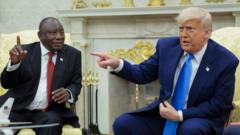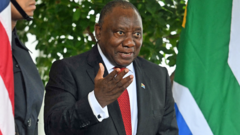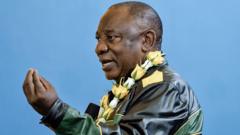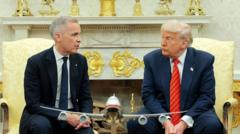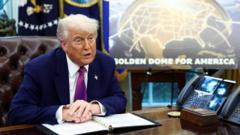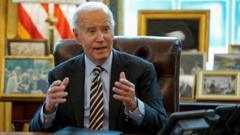**The article delves into the challenges and implications surrounding Trump's ambitious 'Golden Dome' project aimed at modernizing national security against advanced missile threats.**
**Can Trump Deliver the Golden Dome? New Defense Frontier Explored**
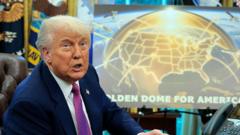
**Can Trump Deliver the Golden Dome? New Defense Frontier Explored**
**In response to emerging threats, Trump’s proposed defense initiative may reshape U.S. missile defense strategy.**
The call for a "Golden Dome" missile defense system by President Donald Trump is raising eyebrows and alarms across military and political circles. As the U.S. faces evolving geopolitical threats, the president's initiative aims to create a multi-layered defense shield to counteract advanced weapon technologies.
Recent discussions in defense circles have highlighted fears of high-tech attacks bearing down on American infrastructure, warning that existing missile defense systems may be insufficient to handle newer threats such as hypersonic missiles and orbital bombardments. A single nuclear detonation in the atmosphere could trigger an electromagnetic pulse (EMP) capable of disrupting life as Americans know it, rendering electronics and critical infrastructure useless. An impending breakdown of society could ensue amidst chaos, with experts indicating that recovery from such an event would take hundreds, if not thousands, of years.
In response, Trump’s "Golden Dome" project aims to bolster America’s defenses against these potential threats, especially as rivals such as Russia and China enhance their own military capabilities. According to missile defense specialists, current systems focus primarily on intercontinental ballistic missiles, yet adversaries have developed advanced technologies posing broader threats.
Experts like Patrycja Bazylczyk stress the project’s necessity, spotlighting its objective to transform the U.S. missile defense strategy towards countering great power adversaries who are adopting advanced strike capabilities. The Golden Dome aims to add layers of protection across land, sea, and space, envisioned to counter not just ballistic missiles but also cruise missiles and other modern threats.
However, intellectual discussions about the Golden Dome are hampered by the lack of information surrounding its design and functionality. Members of Trump's administration, including defense secretary Pete Hegseth, have hinted at its potential capabilities but provided scant details about its actual mechanisms. During a congressional address, Trump stated that this system could be realized by the end of his term, though estimates regarding its costs vary significantly. While Trump claims it could cost $175 billion, the Congressional Budget Office suggests it could demand upwards of $542 billion over the next two decades.
As defense experts analyze the projected costs and challenges, many indicate that rushing to completion could introduce risks, increased expenses, and a system that may not withstand evaluations necessary for effective integration and performance. Moreover, the ambition of the Golden Dome has raised concerns regarding a possible arms race, with potential adversaries such as China now publicly denouncing the move as a catalyst for escalating tensions in space.
Despite the challenges associated with the Golden Dome, experts agree in theory that enhancing homeland air defenses can deter potential aggressors. The Golden Dome aims to alter adversaries' strategic calculus, raising uncertainties over the likelihood of successful strikes against the U.S. homeland.
As the Trump administration continues to navigate this defense initiative, one thing remains evident: the stakes are high and the path ahead appears fraught with complexity. If the Golden Dome can be developed successfully, many, including weapons researcher William Fortschen, believe it could significantly bolster U.S. security efforts against unprecedented threats.
Recent discussions in defense circles have highlighted fears of high-tech attacks bearing down on American infrastructure, warning that existing missile defense systems may be insufficient to handle newer threats such as hypersonic missiles and orbital bombardments. A single nuclear detonation in the atmosphere could trigger an electromagnetic pulse (EMP) capable of disrupting life as Americans know it, rendering electronics and critical infrastructure useless. An impending breakdown of society could ensue amidst chaos, with experts indicating that recovery from such an event would take hundreds, if not thousands, of years.
In response, Trump’s "Golden Dome" project aims to bolster America’s defenses against these potential threats, especially as rivals such as Russia and China enhance their own military capabilities. According to missile defense specialists, current systems focus primarily on intercontinental ballistic missiles, yet adversaries have developed advanced technologies posing broader threats.
Experts like Patrycja Bazylczyk stress the project’s necessity, spotlighting its objective to transform the U.S. missile defense strategy towards countering great power adversaries who are adopting advanced strike capabilities. The Golden Dome aims to add layers of protection across land, sea, and space, envisioned to counter not just ballistic missiles but also cruise missiles and other modern threats.
However, intellectual discussions about the Golden Dome are hampered by the lack of information surrounding its design and functionality. Members of Trump's administration, including defense secretary Pete Hegseth, have hinted at its potential capabilities but provided scant details about its actual mechanisms. During a congressional address, Trump stated that this system could be realized by the end of his term, though estimates regarding its costs vary significantly. While Trump claims it could cost $175 billion, the Congressional Budget Office suggests it could demand upwards of $542 billion over the next two decades.
As defense experts analyze the projected costs and challenges, many indicate that rushing to completion could introduce risks, increased expenses, and a system that may not withstand evaluations necessary for effective integration and performance. Moreover, the ambition of the Golden Dome has raised concerns regarding a possible arms race, with potential adversaries such as China now publicly denouncing the move as a catalyst for escalating tensions in space.
Despite the challenges associated with the Golden Dome, experts agree in theory that enhancing homeland air defenses can deter potential aggressors. The Golden Dome aims to alter adversaries' strategic calculus, raising uncertainties over the likelihood of successful strikes against the U.S. homeland.
As the Trump administration continues to navigate this defense initiative, one thing remains evident: the stakes are high and the path ahead appears fraught with complexity. If the Golden Dome can be developed successfully, many, including weapons researcher William Fortschen, believe it could significantly bolster U.S. security efforts against unprecedented threats.

